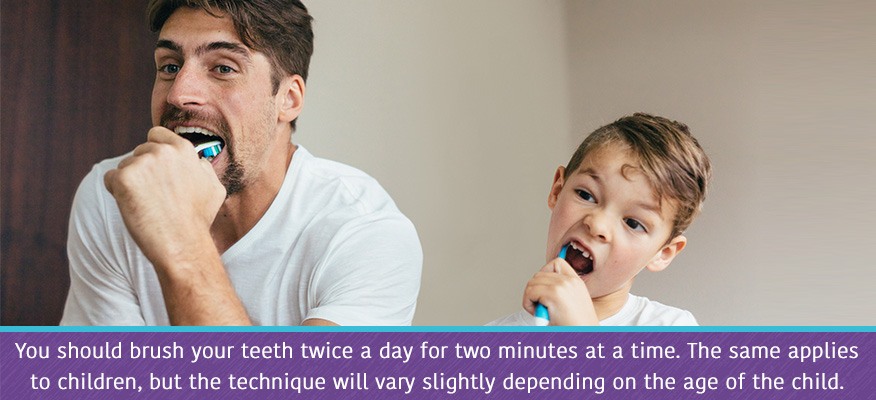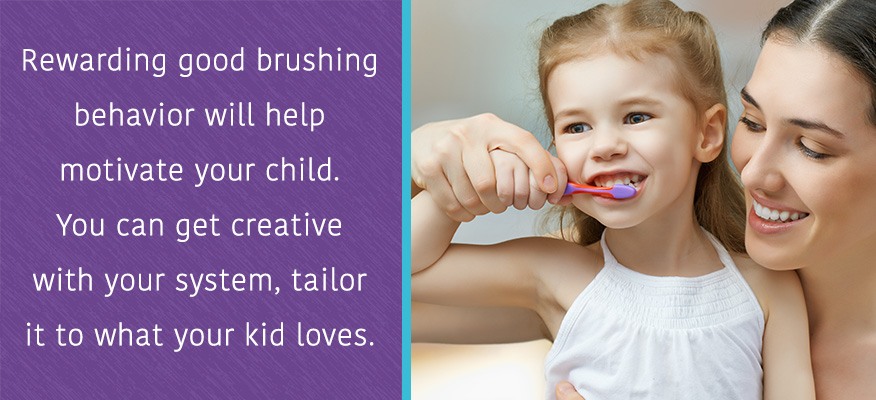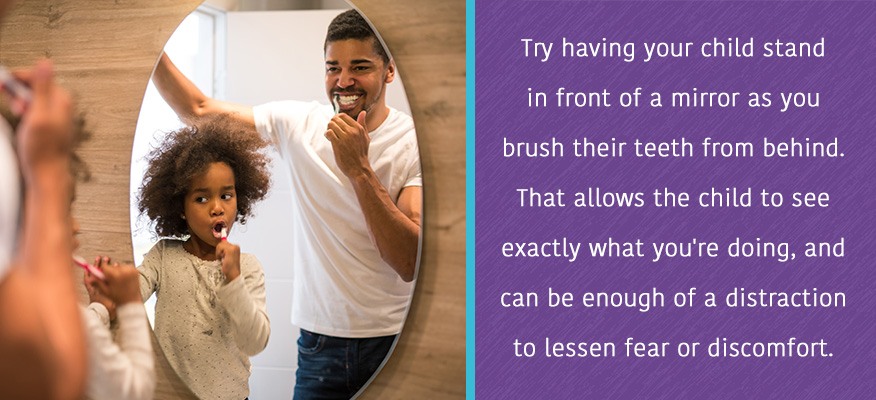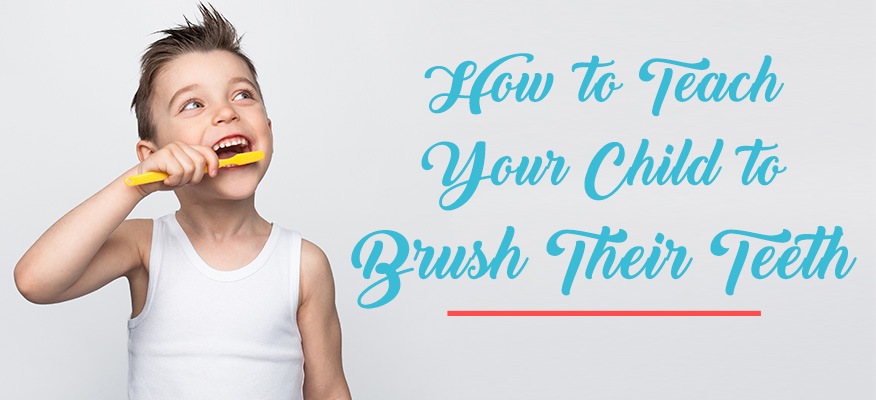Like buckling a seatbelt or looking both ways before crossing a street, teaching your child to brush their teeth is essential for their long-term health.
Teaching children good toothbrushing habits matters. More than 40 percent of kids have cavities before they begin kindergarten, and tooth decay is the top ailment in young children. According to the American Academy of Pediatrics, it occurs five times as often as asthma and seven times more than common allergies. But a child’s teeth aren’t permanent. It takes three years for a complete set of 20 “baby teeth” to come in. By the time they are 12 or 13, these primary teeth have fallen out in place of adult, permanent teeth. If a kid is going to lose their baby teeth anyway, does it matter if they brush regularly?
Yes, as it turns out. Baby teeth are vital for proper oral formation. They act as guides for permanent adult teeth, and if they fall out prematurely, adult teeth may not have enough room to come in correctly. Decaying baby teeth can also lead to problems like:
- Difficulty eating and speaking
- Pain/Discomfort
- Infections and
- Low self-esteem
However, as any parent knows, teaching your child to brush their teeth is not a straightforward process. It can be hard to determine when and how to start forming your child’s dental habits, especially if they react to “toothbrushing time” with tears and meltdowns. We understand brushing your child’s teeth can be frustrating and confusing. But it doesn’t have to be. We’ve compiled our best tips and tricks to make toothbrushing an enjoyable process that sets your child up for long-term dental health.
When to Start Brushing
It’s essential to begin brushing your child’s teeth at an early age, to both form good habits and to promote long-term oral health. You can even begin before the first tooth appears. With infants, it’s important to keep the gums clean. Gently wipe your baby’s gums with a soft cloth and water after each feeding. If you can, move from a cloth to a wet, infant-sized toothbrush with soft bristles — beginning your child with a toothbrush eliminates a sometimes tricky transition from cloths to toothbrushes. Another benefit to cleaning your infant’s gums is that the light pressure from the rubbing can give relief from the aches and pains of teething.
A child’s teeth may come in earlier than you think. For some kids, the first tooth appears when they’re 6 or 7 months old. As soon as that first tooth shows up, start a brushing routine. It’s best to brush teeth twice a day, preferably in the morning after breakfast and before bed at night.
How to Brush Teeth Correctly
Before you start teaching your child how to brush their teeth, take a moment to double-check you’re cleaning your teeth correctly. According to the American Dental Association, the proper toothbrushing technique lasts a minimum of two minutes and includes the following steps:
- Begin by tilting your toothbrush at a 45-degree angle to the gums. The angle is important — it will target the areas near the gum line where plaque accumulates most.
- Next, gently move the brush in tooth-wide strokes, scrubbing back and forth over the teeth.
- With this rhythm, brush the inner surfaces, outer surfaces and chewing surfaces of the teeth.
- To reach the inside surfaces of the front teeth, tilt your toothbrush vertically and brush in vertical motions.
- Brush the surface of the tongue to scrub off bacteria and food debris.

You should brush your teeth twice a day for two minutes at a time. The same applies to children, but the technique will vary slightly depending on the age of the child.
1. Infants
For infants, clean the gums and mouth after each feeding to reduce the buildup of sugars from food or milk and make it harder for bacteria to grow. Use a clean wet cloth or xylitol wipe until the child grows their first tooth — at this point, switch to an infant-sized, soft-bristled toothbrush. Beginning your child on a toothbrush instead of cloths or wipes can reduce the chance of them reacting poorly to toothbrushes later.
2. Toddlers
Although they have adorable toothy grins, toddlers don’t yet have a full set of teeth. To care for their growing teeth and tender gums, use a pea-sized amount of flouride toothpaste. If your child is younger than 2 or has trouble spitting, use an even smaller, rice-sized amount — it won’t be harmful if they swallow it.
- Find a comfortable position for both you and your child. Some children find it easiest to sit or lie down in their parents’ laps, while some prefer to stand on a stepstool.
- Angle the toothbrush 45 degrees toward the gum line and move it back and forth with short strokes.
- Begin cleaning the inner surfaces of the teeth before moving to the outer and chewing surfaces.
- Because you’re using just a small amount of toothpaste, it is okay if your child swallows it.
3. Children

After reaching their third birthday, your child will have a full set of baby teeth. They’re now old enough to begin learning how to brush their teeth themselves. Because young children don’t have the motor skills to expert tooth-brushers, this learning process will span years — often until they’re between 6 and 8 years old.
- You or your child should angle the brush 45 degrees toward the gums.
- Using short strokes, move the toothbrush back and forth along every tooth’s interior and exterior.
- Angle the tip of the brush upright to clean the hard-to-reach areas behind the top and bottom teeth.
- Brush the tongue to scrub away bacteria.
When a child is old enough to brush their teeth, you should still inspect them regularly to see if your kid is missing any areas. As a general rule of thumb, keep brushing your child’s teeth, at least occasionally, until they are 7 years old.
How to Teach Your Children to Brush Their Teeth
Teaching your kids to brush their teeth, and even enjoy it, doesn’t have to be impossible. Here are some tips to make the training years fun for the whole family.
1. Have the Right Supplies
The right materials can make or break a toothbrushing session. For children, use a soft, small-headed toothbrush to remove food debris, bacteria and sticky plaque. Stiff bristles are often abrasive on a young child’s sensitive gums. Replace the toothbrush every three to four months or when it looks frayed or worn. Also, consider replacing a toothbrush after a child has had a cold or the flu — nothing is worse than re-introducing germs into a kid’s exhausted immune system.
Try letting your child choose a toothbrush or toothpaste they like. Character brushes are more fun than boring, solid-color models, and toothpaste can come in a wide range of flavors. Giving your child a choice in their toothbrush and toothpaste gives them ownership in the toothbrushing routine, and helps foster a positive relationship with dental hygiene.
2. Stick to a Routine
Set a toothbrushing routine and stick with it. It can be tempting to skip a session after a long day, or when you’re on vacation and your regular schedule gets disrupted. Avoid the temptation to cut out or shorten a toothbrushing session. Your child will begin to think brushing their teeth is not essential, which can undermine your teaching efforts.
3. Include the Family
Make brushing your teeth a family event. Let all members of your family clean their teeth together in the same room. Set a timer and maybe even play some music. When brushing your teeth becomes a time for family bonding and fun, children are more willing and interested in participating.
4. Make It Fun
Who said brushing your teeth had to be boring? Play your kid’s favorite song and make up a dance, or brush your teeth to the rhythm of the music. Read a story out loud using all your best, goofy voices. Find short videos to watch while brushing, or let your child interact with a toothbrushing app. The options are endless. When a routine is fun, your child will start looking forward to it.
5. Set an Example
Brush your teeth in front of your kid. Let them see it’s something you have to do, too. When brushing your teeth, narrate every step. Do the same when you’re brushing your kid’s teeth — let them know what you’re doing, why you’re doing it and what’s coming up next. This helps normalize toothbrushing and eliminates any surprises from the routine.
6. Create a Rewards System

Rewarding good brushing behavior will help motivate your child. You can get creative with your system — tailor it to what your kid loves. Is your toddler obsessed with stickers? Make a calendar and let them add a new sticker every day they brush their teeth. If your child soaks up stories, let them choose the bedtime story as a reward for brushing. For older children, you could use the sticker method for more significant prizes. Every three stickers could mean an afternoon at the park, for example. Some kids just want your affirmation — saying you’re proud of them could be enough positive reinforcement.
7. Ease Into It
As your kid gets old enough to brush their teeth, take turns with them in the bathroom. Begin by brushing the child’s teeth first, and then have them repeat what you just did. By gradually increasing the time your child spends brushing their teeth, you ease them into independent toothbrushing without a struggle.
Check Out Other Dental Hygiene Tips for Kids
Tips for a Wiggly or Obstinate Child
Sometimes, no matter what you try, your child just doesn’t like brushing their teeth. A nightly session can end with tears and toothpaste on every surface. Days like this are no fun for anyone. Here are some ideas for those times when your child won’t cooperate.
1. Stay Positive
The last thing you need is for your child to develop dental phobia or resentment towards brushing their teeth. Even if your child hates brushing their teeth, never threaten them with dental visits if they don’t brush. That will only create a hostile attitude towards dental hygiene, and it can be hard to break those early childhood associations — more than 50 percent of the adult population avoids dentists unless they are in pain. Instead, try creating positive rewards to reinforce good behavior.
2. Be an Example
Let your child see everyone brushes their teeth, even you — toothbrushing is important, painless and normal. Even if they’re not brushing with you, make it a fun experience. Jump around, crack jokes, make silly noises, play music — show them you enjoy brushing your teeth and that it can be fun. You can even let your child brush your teeth, but try not to make any faces or noises if they accidentally poke you in the gums!
3. Get out of the Bathroom
Don’t limit toothbrushing to the bathroom. Parade through the living room to a funny march, or brush in the woods after a family hike or at the park after a picnic. You can still keep the routine of brushing twice a day, but in a variety of new and novel locations.
4. Try New Supplies
If your child gags at the taste of toothpaste, try just brushing with water. The brushing is more important than the paste, so if you can’t find toothpaste your child enjoys, cut it out for a season or try making your own. An electric toothbrush could be an exciting and enticing addition to your toothbrushing routine, and if it’s hard to get your child to brush for more than short bursts, an electric brush may even be more effective.
5. Let Them Watch

Try having your child stand in front of a mirror as you brush their teeth from behind. That allows the child to see exactly what you’re doing, and can be enough of a distraction to lessen fear or discomfort.
6. Provide Distractions
Young children tend to be highly kinesthetic. Swap a digital timer for an hourglass for a visual way to keep time during toothbrushing sessions. Give your child something interesting to hold and play with while you’re brushing their teeth to distract or calm them. That will keep them focused on something beyond their teeth. Try telling your child a story while you brush their teeth. Maybe put your child into the story, making them a character who has to defeat the “bad guys” that bring cavities. Only continue the story during toothbrushing sessions, giving your child something to look forward to.
Getting your child to brush their teeth can be hard, but it would be worse for them to have painful teeth or fillings. If your kid can’t tolerate twice-a-day toothbrushing, try reducing it to just nights for a while. Although it’s important to brush in the morning, it’s more important to clean your teeth before bed. While a child sleeps, bacteria have a chance to grow and feed relatively undisturbed, and the leftover sugar from food or milk is a perfect environment.
How to Prepare for a First Dental Visit
Don’t Forget Regular Checkups
Regular dental checkups are an essential component of your child’s oral hygiene. Routinely visiting a dentist will reinforce the lessons you’re teaching them at home, and will allow dental experts to examine your child’s teeth and gums. Dental appointments can begin when your child is 6 months old or after their first birthday. A pediatric dentist can give your kid an engaging, professional lesson about teeth and how to care for them, as well as monitor their teeth development. A dentist can notice warning signs before cavities and infections begin, and regular visits are an important part of a preventive health model.
At Fox Kids Dentistry & Orthodontics in Portland, we are trained in pediatric dentistry — we have specifically studied children’s dental care. We provide the highest-quality, compassionate dental care in a cheerful and fun environment children actually look forward to visiting. Contact us today to schedule an appointment — we’re hoping to see you soon!
Schedule A Pediatric Dentist Appointment in Portland
Does your child need a pediatric dental appointment? Call us at 503-223-5039 to schedule your visit to our downtown Portland location!



